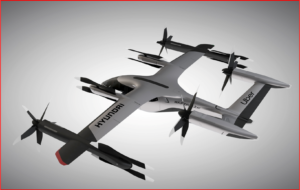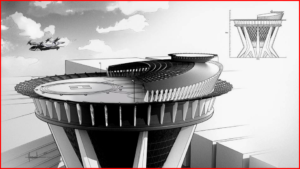
Vaper Ware or Vader Ware?
Uber and Hyundai Motor Company today announced a new partnership to develop Uber Air Taxis for a future aerial ride-share network and unveiled a new full-scale aircraft concept at the Consumer Electronics Show (CES).
Hyundai is the first automotive company to join the Uber Elevate initiative, bringing automotive-scale manufacturing capability and a track record of mass-producing electric vehicles.

Moving traffic jams skywards?
The air vehicle concept Hyundai released today was created in part through a NASA-inspired approach that jump-starts innovation by publicly releasing vehicle design concepts so any company can use them to innovate their air taxi models and engineering technologies.
In this partnership, Hyundai will produce and deploy the air vehicles, and Uber will provide airspace support services, connections to ground transportation, and customer interfaces through an aerial ride share network. Both parties are collaborating on infrastructure concepts to support take-off and landing for this new class of vehicles.
“Our vision of Urban Air Mobility will transform the concept of urban transportation,” claimed Jaiwon Shin, Executive Vice President and Head of Hyundai’s Urban Air Mobility (UAM) Division. “We expect UAM to vitalize urban communities and provide more quality time to people.”
“We believe Hyundai has the potential to build Uber Air vehicles at rates unseen in the current aerospace industry, producing high quality, reliable aircraft at high volumes to drive down passenger costs per trip,” said Eric Allison, head of Uber Elevate.
In preparation for this announcement, Hyundai has worked with Uber Elevate to develop a PAV (Personal Air Vehicle) model, S-A1, that is said to optimize electric vertical take-off and landing (eVTOL) aircraft for aerial ridesharing purposes.
The Elevate initiative based this process on NASA’s historical approach of putting design concepts out publicly to inspire innovation among multiple companies, spurring the development of common research models to investigate novel aerodynamic concepts and catalyzing industry progress in wing design, noise, aerodynamics, and simulation verification.
As a result, Hyundai’s S-A1 model unveiled at CES reflects previous eVTOL designs Uber Elevate has released in the following ways:
- It is designed for a cruising speed up to 180 miles/hr (290 km/hr), a cruising altitude of around 1,000-2,000 feet (300 – 600 meters) above ground, and to fly trips up to 60 mile (100 km).
- The Hyundai vehicle will be 100% electric, using distributed electric propulsion and during peak hours will require about five to seven minutes for recharging.
- Distributed electric propulsion, powering multiple rotors and propellers around the airframe is to increase safety by decreasing any single point of failure. Having several, smaller rotors also reduces noise relative to large rotor helicopters with combustion engines, which is very important to cities.
- The model is designed to take off vertically, transition to wing-borne lift in cruise, and then transition back to vertical flight to land.
- The Hyundai vehicle will be piloted initially, but over time they will become autonomous.
- The cabin is designed with four passenger seats, allowing riders to board / disembark easily and avoid the dreaded middle seat with enough space for a personal bag or backpack / rider.
Uber Elevate
Uber has announced a goal of flight demonstrations in 2020 and Elevate commercially available to riders in 2023. Uber entered into partnerships with several manufacturers including Hyundai Motor Group, Aurora Flight Sciences (now a subsidiary of Boeing), Bell, Embraer, Joby Aviation, Pipistrel Aircraft, Karem Aircraft and Jaunt Air Mobility. Uber has also entered into a real estate partnerships with Hillwood Properties, Related, Macquire, Oaktree and Signature.
Uber has signed two Space Act Agreements with NASA one for the development of new Unmanned Traffic Management concepts and Unmanned Aerial Systems; another to explore concepts and technologies for Urban Air Mobility. Uber’s analysis projects that an electric vehicle will travel at a speed up to 200 mph and that eventually, after several years in a market, an Uber Elevate ride will cost the same as an UberX trip of the same distance.
Hyundai Motor
Established in 1967, Hyundai Motor Company has 110,000 employees worldwide, and it has sold more than 4.5 million vehicles. Hyundai Motor continues to expand its product line-up with vehicles, such as NEXO, the world’s first dedicated hydrogen-powered SUV.

About Ken Zino
Ken Zino, editor and publisher of AutoInformed, is a versatile auto industry participant with global experience spanning decades in print and broadcast journalism, as well as social media. He has automobile testing, marketing, public relations and communications experience. He is past president of The International Motor Press Assn, the Detroit Press Club, founding member and first President of the Automotive Press Assn. He is a member of APA, IMPA and the Midwest Automotive Press Assn.
He also brings an historical perspective while citing their contemporary relevance of the work of legendary auto writers such as Ken Purdy, Jim Dunne or Jerry Flint, or writers such as Red Smith, Mark Twain, Thomas Jefferson – all to bring perspective to a chaotic automotive universe.
Above all, decades after he first drove a car, Zino still revels in the sound of the exhaust as the throttle is blipped during a downshift and the driver’s rush that occurs when the entry, apex and exit points of a turn are smoothly and swiftly crossed. It’s the beginning of a perfect lap.
AutoInformed has an editorial philosophy that loves transportation machines of all kinds while promoting critical thinking about the future use of cars and trucks.
Zino builds AutoInformed from his background in automotive journalism starting at Hearst Publishing in New York City on Motor and MotorTech Magazines and car testing where he reviewed hundreds of vehicles in his decade-long stint as the Detroit Bureau Chief of Road & Track magazine. Zino has also worked in Europe, and Asia – now the largest automotive market in the world with China at its center.


Uber and Hyundai Show Full-Scale Air Taxi at CES
Vaper Ware or Vader Ware?
Uber and Hyundai Motor Company today announced a new partnership to develop Uber Air Taxis for a future aerial ride-share network and unveiled a new full-scale aircraft concept at the Consumer Electronics Show (CES).
Hyundai is the first automotive company to join the Uber Elevate initiative, bringing automotive-scale manufacturing capability and a track record of mass-producing electric vehicles.
Moving traffic jams skywards?
The air vehicle concept Hyundai released today was created in part through a NASA-inspired approach that jump-starts innovation by publicly releasing vehicle design concepts so any company can use them to innovate their air taxi models and engineering technologies.
In this partnership, Hyundai will produce and deploy the air vehicles, and Uber will provide airspace support services, connections to ground transportation, and customer interfaces through an aerial ride share network. Both parties are collaborating on infrastructure concepts to support take-off and landing for this new class of vehicles.
“Our vision of Urban Air Mobility will transform the concept of urban transportation,” claimed Jaiwon Shin, Executive Vice President and Head of Hyundai’s Urban Air Mobility (UAM) Division. “We expect UAM to vitalize urban communities and provide more quality time to people.”
“We believe Hyundai has the potential to build Uber Air vehicles at rates unseen in the current aerospace industry, producing high quality, reliable aircraft at high volumes to drive down passenger costs per trip,” said Eric Allison, head of Uber Elevate.
In preparation for this announcement, Hyundai has worked with Uber Elevate to develop a PAV (Personal Air Vehicle) model, S-A1, that is said to optimize electric vertical take-off and landing (eVTOL) aircraft for aerial ridesharing purposes.
The Elevate initiative based this process on NASA’s historical approach of putting design concepts out publicly to inspire innovation among multiple companies, spurring the development of common research models to investigate novel aerodynamic concepts and catalyzing industry progress in wing design, noise, aerodynamics, and simulation verification.
As a result, Hyundai’s S-A1 model unveiled at CES reflects previous eVTOL designs Uber Elevate has released in the following ways:
Uber Elevate
Uber has announced a goal of flight demonstrations in 2020 and Elevate commercially available to riders in 2023. Uber entered into partnerships with several manufacturers including Hyundai Motor Group, Aurora Flight Sciences (now a subsidiary of Boeing), Bell, Embraer, Joby Aviation, Pipistrel Aircraft, Karem Aircraft and Jaunt Air Mobility. Uber has also entered into a real estate partnerships with Hillwood Properties, Related, Macquire, Oaktree and Signature.
Uber has signed two Space Act Agreements with NASA one for the development of new Unmanned Traffic Management concepts and Unmanned Aerial Systems; another to explore concepts and technologies for Urban Air Mobility. Uber’s analysis projects that an electric vehicle will travel at a speed up to 200 mph and that eventually, after several years in a market, an Uber Elevate ride will cost the same as an UberX trip of the same distance.
Hyundai Motor
Established in 1967, Hyundai Motor Company has 110,000 employees worldwide, and it has sold more than 4.5 million vehicles. Hyundai Motor continues to expand its product line-up with vehicles, such as NEXO, the world’s first dedicated hydrogen-powered SUV.
About Ken Zino
Ken Zino, editor and publisher of AutoInformed, is a versatile auto industry participant with global experience spanning decades in print and broadcast journalism, as well as social media. He has automobile testing, marketing, public relations and communications experience. He is past president of The International Motor Press Assn, the Detroit Press Club, founding member and first President of the Automotive Press Assn. He is a member of APA, IMPA and the Midwest Automotive Press Assn. He also brings an historical perspective while citing their contemporary relevance of the work of legendary auto writers such as Ken Purdy, Jim Dunne or Jerry Flint, or writers such as Red Smith, Mark Twain, Thomas Jefferson – all to bring perspective to a chaotic automotive universe. Above all, decades after he first drove a car, Zino still revels in the sound of the exhaust as the throttle is blipped during a downshift and the driver’s rush that occurs when the entry, apex and exit points of a turn are smoothly and swiftly crossed. It’s the beginning of a perfect lap. AutoInformed has an editorial philosophy that loves transportation machines of all kinds while promoting critical thinking about the future use of cars and trucks. Zino builds AutoInformed from his background in automotive journalism starting at Hearst Publishing in New York City on Motor and MotorTech Magazines and car testing where he reviewed hundreds of vehicles in his decade-long stint as the Detroit Bureau Chief of Road & Track magazine. Zino has also worked in Europe, and Asia – now the largest automotive market in the world with China at its center.